MidMoTreasure
Sr. Member
- Jul 2, 2012
- 335
- 713
- Detector(s) used
- Minelab CTX 3030, Minelab E-Trac, Garrett Super Sluice, Banjo Pan
- Primary Interest:
- All Treasure Hunting
Gold fever is not a disease that typically affects Central Missourians like myself. We are a good day’s drive away from the closest gold-bearing regions in Colorado and Georgia, and this geographic isolation is a good natural defense to the fever. Other treasure abounds. I caught the treasure bug at the age of six when my great-grandfather would take me for walks in the fields and creeks to search for arrowheads. For years, head hunting was my primary treasure hunting activity and I got pretty good at sniffing out points in the Missouri streams and fields.
When the recession hit, the price of precious metals began to sore faster than my blood-alcohol content on a Wednesday night during college. I had been a coin collector for a while, and I got cranky that I could no longer “afford” to buy common-date silver coins. I knew that people used these weed-eater looking thingies called metal detectors to find coins in the ground — for free!! — so I ordered a cheap Bounty Hunter and an even cheaper garden spade and hit the dirt. After a month of digging nails and beer bottle caps, I was about to give up when BAM! I pulled a silver dime and an Indian Head cent. More followed, and I upgraded to better equipment. More silver and old coins surrendered to me and then I started finding Civil War artifacts. Treasure is awesome!
So what does this have to do with gold prospecting? It was 2013 and my interest in gold at that point had been confined to the few pieces of jewelry I had found metal detecting, and the hordes of gold coins I dreamed of digging. I was watching some detecting videos on the Youtubes when I saw a recommendation for videos by a strange looking fella in a buckskin shirt named Jeff Williams. I clicked and enjoyed his goofy persona and antics (the bourbon I was drinking probably helped too). After many videos, I found I was actually learning a little about prospecting and panning and developing a mild gold-cold, so I ordered the Garrett Gold Panning Newbie Kit and Brisket Recipe (recipes not included) and some crappy “super rich awesome good mega” paydirt from Amazon. I panned through it in a wash tub in my back yard, found some of the salted fines, and kept those pretty colors in a vial. I ordered some more dirt from one of the big-name companies.
Somehow, life happened and I never got to pan that out. The dirt, my spoils from the earlier dirt, and my Garrett kit ended up in a cabinet in my workshop. Fast forward to this year (2017), I was watching one of the TV gold shows with my kids — not sure which one because I watch them all, with copious amounts of bourbon of course — and my oldest daughter told me she wanted to find gold. My gold-cold that had been laying dormant suddenly raged, and I remembered the pans and paydirt I had squirrelled away. I got it all out, filled up the old wash tub, a little squirt of Jet Dry, and we were a-panning away. When I got down to backwashing the black sands and that beautiful yellow color began showing through, I felt the fever hit. I went through the old spoils and found gold that I had missed. The color was there in the pan, winking and blowing kissy-faces at me.
I educated myself as best as I could on proper panning, prospecting, and bad karaoke, all of which I felt would be necessary for a prospecting trip to a gold-bearing region in the beautiful U-S-of-A. I was set on Georgia, and began doing research. Somewhere in my perusing of Dahlonega rock porn, I came across a blurb about glaciers and how they kindly push gold from the Canadian Shield down to otherwise barren parts of the country. Suddenly, Georgia seemed way too far, and I zeroed my research in on my home state. I read some stuff about GPAA chapters in Missouri and how they find this glacial gold north of the Missouri River. I read tales about this mysterious Missouri mineral miser named russau on TNet, and how he finds the color in his beloved “Misery.” I saw actual videos of Missouri folk finding the gold in streams that I had walked for arrowheads in the past. Then I learned that Chuck Lassiter had literally written the book on Midwest glacial gold. I read everything I could, twice. I watched videos, lurked on forums, studied maps, and scribbled down sheets of notes, mad-scientist style.
The fever called to me like a plate of chili cheese fries when my wife has been force-feeding me salad for a week. The only cure was seeing color in my pan. I studied the local geology and zeroed in on a spot not too far from my home that had all the trademarks of a Midwestern glacial gold zone. The only thing left to do was get boots on the ground and material in the pan. The weekend forecast looked stunning — all happiness and sunshine. The wife and kids were up for an adventure. It was time I surrender to the fever and become a real-life prospector. Well, as close as a Missourian can be anyhow.
My name is Bryan, and I am a Missouri prospector and treasure hunter. Pleased to meet y’all.
When the recession hit, the price of precious metals began to sore faster than my blood-alcohol content on a Wednesday night during college. I had been a coin collector for a while, and I got cranky that I could no longer “afford” to buy common-date silver coins. I knew that people used these weed-eater looking thingies called metal detectors to find coins in the ground — for free!! — so I ordered a cheap Bounty Hunter and an even cheaper garden spade and hit the dirt. After a month of digging nails and beer bottle caps, I was about to give up when BAM! I pulled a silver dime and an Indian Head cent. More followed, and I upgraded to better equipment. More silver and old coins surrendered to me and then I started finding Civil War artifacts. Treasure is awesome!
So what does this have to do with gold prospecting? It was 2013 and my interest in gold at that point had been confined to the few pieces of jewelry I had found metal detecting, and the hordes of gold coins I dreamed of digging. I was watching some detecting videos on the Youtubes when I saw a recommendation for videos by a strange looking fella in a buckskin shirt named Jeff Williams. I clicked and enjoyed his goofy persona and antics (the bourbon I was drinking probably helped too). After many videos, I found I was actually learning a little about prospecting and panning and developing a mild gold-cold, so I ordered the Garrett Gold Panning Newbie Kit and Brisket Recipe (recipes not included) and some crappy “super rich awesome good mega” paydirt from Amazon. I panned through it in a wash tub in my back yard, found some of the salted fines, and kept those pretty colors in a vial. I ordered some more dirt from one of the big-name companies.
Somehow, life happened and I never got to pan that out. The dirt, my spoils from the earlier dirt, and my Garrett kit ended up in a cabinet in my workshop. Fast forward to this year (2017), I was watching one of the TV gold shows with my kids — not sure which one because I watch them all, with copious amounts of bourbon of course — and my oldest daughter told me she wanted to find gold. My gold-cold that had been laying dormant suddenly raged, and I remembered the pans and paydirt I had squirrelled away. I got it all out, filled up the old wash tub, a little squirt of Jet Dry, and we were a-panning away. When I got down to backwashing the black sands and that beautiful yellow color began showing through, I felt the fever hit. I went through the old spoils and found gold that I had missed. The color was there in the pan, winking and blowing kissy-faces at me.
I educated myself as best as I could on proper panning, prospecting, and bad karaoke, all of which I felt would be necessary for a prospecting trip to a gold-bearing region in the beautiful U-S-of-A. I was set on Georgia, and began doing research. Somewhere in my perusing of Dahlonega rock porn, I came across a blurb about glaciers and how they kindly push gold from the Canadian Shield down to otherwise barren parts of the country. Suddenly, Georgia seemed way too far, and I zeroed my research in on my home state. I read some stuff about GPAA chapters in Missouri and how they find this glacial gold north of the Missouri River. I read tales about this mysterious Missouri mineral miser named russau on TNet, and how he finds the color in his beloved “Misery.” I saw actual videos of Missouri folk finding the gold in streams that I had walked for arrowheads in the past. Then I learned that Chuck Lassiter had literally written the book on Midwest glacial gold. I read everything I could, twice. I watched videos, lurked on forums, studied maps, and scribbled down sheets of notes, mad-scientist style.
The fever called to me like a plate of chili cheese fries when my wife has been force-feeding me salad for a week. The only cure was seeing color in my pan. I studied the local geology and zeroed in on a spot not too far from my home that had all the trademarks of a Midwestern glacial gold zone. The only thing left to do was get boots on the ground and material in the pan. The weekend forecast looked stunning — all happiness and sunshine. The wife and kids were up for an adventure. It was time I surrender to the fever and become a real-life prospector. Well, as close as a Missourian can be anyhow.
My name is Bryan, and I am a Missouri prospector and treasure hunter. Pleased to meet y’all.



 ? Then I wonder what this stuff is I've been getting ?? it's small but .................... No gold you say?? The streams in upper Misery have what your looking for!
? Then I wonder what this stuff is I've been getting ?? it's small but .................... No gold you say?? The streams in upper Misery have what your looking for!
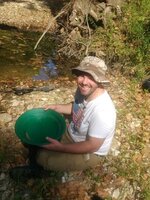
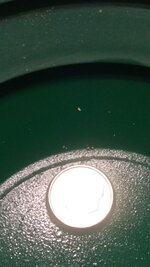
 congrats on doing real prospecting to find your own gold!!!
congrats on doing real prospecting to find your own gold!!!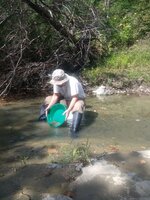
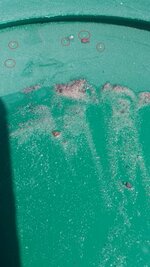
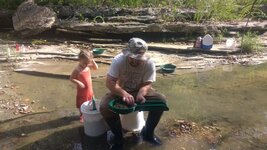
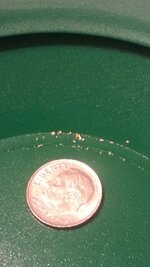
 Have you ever thought about the fact you may also be losing/panning out some much smaller gold from those pans? When you get down to the heavies then do your panning into a safety pan to collect those tails to take home, classify to individual mesh sizes (say +30, +50 and + and - 100) and pan each batch separately. Gold is king in a pan no matter the size it is as long as it matched with only similarly sized material. You might just surprise your self with what you have been missing. Finding "micro" gold is not as gratifying as larger flakes but it all adds up.
Have you ever thought about the fact you may also be losing/panning out some much smaller gold from those pans? When you get down to the heavies then do your panning into a safety pan to collect those tails to take home, classify to individual mesh sizes (say +30, +50 and + and - 100) and pan each batch separately. Gold is king in a pan no matter the size it is as long as it matched with only similarly sized material. You might just surprise your self with what you have been missing. Finding "micro" gold is not as gratifying as larger flakes but it all adds up.